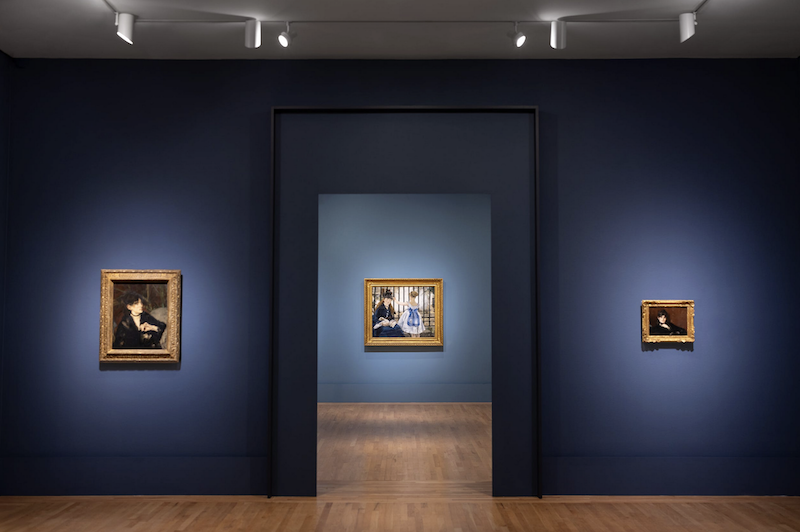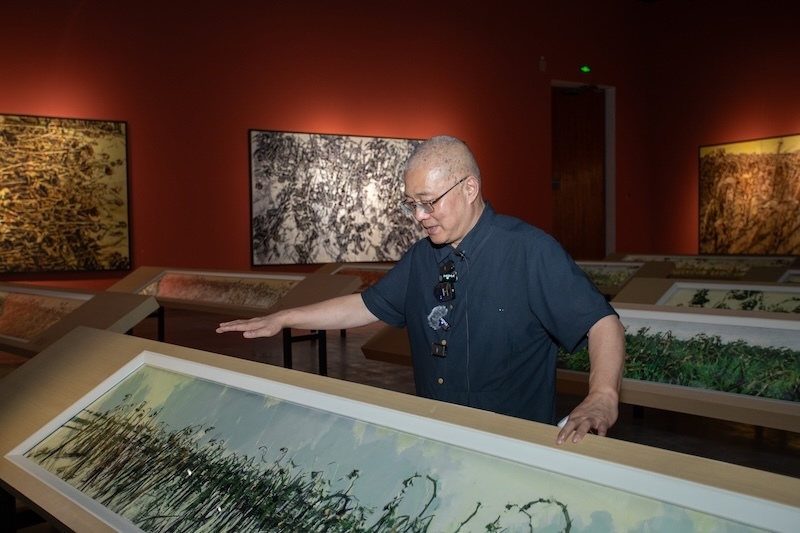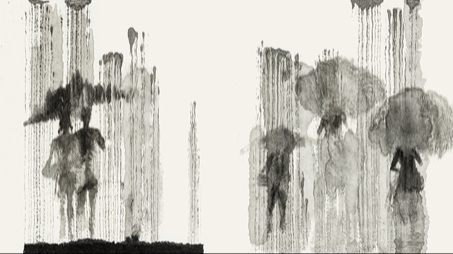
Édouard Manet (1832-1883) and Berthe Morisot (1841-1895), the former a pioneer of modern painting, the latter a female artist within the Impressionist school. Recently, the Legion of Honor Museum in San Francisco presented a special exhibition, "Manet and Morisot," which explored their artistic friendship and the mutual influence they fostered in their work.
Morisot's own work was initially seen as an extension of Manet's, but in the final years of his life, Manet gradually adopted Morisot's style in subject matter, color, and brushwork.
While the 2023 "Manet/Degas" exhibition at the Metropolitan Museum of Art in New York presented a head-on confrontation, the new exhibition "Manet and Morisot" at the Legion of Honor in San Francisco offers a unique blend of the spirit and sensibility of two highly influential artists: Édouard Manet and Berthe Morisot. The exhibition catalog even uses the portmanteau "Marisot," coined by French philosopher Fabienne Brugère, to portray the two 19th-century artists as an artistic celebrity couple. From an artistic perspective, the metaphor is apt.

Exhibition site
The exhibition "Manet & Morisot" both highlights their relationship and successfully liberates Morisot from Manet's shadow. Morisot is often seen as Manet's muse or pupil, an imbalance stemming from both historical biases against female artists and Manet's reputation as a pioneer of Modernism. However, in this exhibition, Morisot's influence on Manet is undeniable.
At the exhibition's opening, Morisot appears in Manet's group portrait, The Balcony. Created shortly after their initial encounter at the Louvre, Morisot's piercing gaze dominates the painting. Years later, when her work had firmly established her as a pioneering Impressionist, Manet broke with his own rigorous realism, adopting her more unfinished style.

Édouard Manet, The Balcony, 1868-1869
They were close friends, frequently exchanging letters, attending the same parties, and passionate advocates of each other's art, eventually becoming in-laws. Morisot, then in her thirties and facing financial hardship following her father's death, married Eugène Manet, Manet's younger brother, with the support of both families. The circumstances of the time also drew them closer; both experienced the Siege of Paris in 1870-71, which saw many friends flee the city while they remained.
Art critics have long speculated that a romantic connection may have existed in their early friendship. However, the exhibition offers no evidence of this. A touch of flirtation can be seen in some of Manet's early portraits of Morisot, such as "Berthe Morisot Reclining." And Morisot's letters to her sister contain tantalizing gossip: "Manet is so constantly teasing me and laughing at my behavior that I find that if he were single I should be more attracted to him than anyone else." Manet was married when they met.

Édouard Manet, Berthe Morisot Reclining, 1873
To be sure, they tested each other's boundaries, as good friends sometimes do. While directing Morisot's portraits of their mother and sister for the Salon, Manet suddenly took up his brush and smeared paint over large areas of the work, leaving Morisot furious before she could make any last-minute adjustments. Years later, Morisot, despite Manet's urgings, left the Salon to participate in the first Impressionist exhibition.

Berthe Morisot, View of Paris from the Place Trocadero (detail), circa 1871-1872

Édouard Manet, The Universal Exhibition, 1867
Their rapport is also remarkable. In modern Paris, they inhabited vastly different worlds. Manet devoted himself to studio painting, while Morisot studied landscape painting with Corot and embraced the Impressionist method of painting outdoors. While Manet could wander freely into cafés, depicting figures in novel and striking ways, Morisot, a woman from the bourgeoisie, was confined to so-called "proper" spaces and subject matter. Manet's figures gazed directly at the viewer with a sharp, almost impertinent gaze, while Morisot primarily depicted interior scenes, gardens, and parks, often depicting figures reading, sewing, or caring for children, appearing reserved and composed.
New inspiration would always arise when the two exchanged subjects. Just months after Morisot posed for Manet’s The Balcony, she painted Young Woman at the Window in 1869, which shows her sister gazing out at the Parisian scene with an open fan.

Berthe Morisot, Young Woman at the Window, 1869, depicts Morisot's sister gazing at a Paris street scene.
Years later, Manet responded to Morisot's similar painting, "Women and Children on a Balcony" (unfortunately not included in the exhibition). He zoomed in, focusing on the railing and the young girl peering through it, and shifted the scene from the shores of the Parc de Passy to the bustling European Quarter. The resulting work, "The Railway" (1873), is a treasure of the National Gallery of Art in Washington, D.C., and a central loan for this exhibition. In this painting, Manet examines the women excluded from the modern city with profound empathy, explicitly reflecting the implications of Morisot's work.

Édouard Manet, The Railway, 1873
While personal and professional transitions can often be stressful for many, Manet and Morisot's friendship endured these challenges. 1874 marked a crucial turning point: Morisot's father died, she participated in her first Impressionist exhibition, and married Manet's brother, Eugène. Two portraits of Morisot from this period capture these shifts in her life. In one, her face is oppressed by the weight of her black hat veil; in the other, her fan draws the eye to her gleaming engagement ring.

Exhibition site
Married life seemed to suit Morisot well. Eugène, who had previously managed his brother's artistic career, later served as his wife's agent and occasional model. He appears in the painting as a caring father, playing in the garden with his and Morisot's daughter, Julie. Motherhood squeezed Morisot's creative time, prompting her to paint more quickly, which in turn fostered a deft, free-flowing brushstroke. In the wild and unrestrained "Woman and Child on the Meadows at Bougival" (1882), the brushstrokes resemble a whirlwind, enveloping Julie and her nurse in a storm of vegetation.

Berthe Morisot, Women and Children on the Meadows at Bougival, 1882
Curated by Emily A. Beeney, Chief Curator and Head of European Paintings at the Legion of Honor, the exhibition "Manet and Morisot" offers a unique insight: Manet's declining health and long periods of confinement at home in the late 1870s closely mirror the domestic scenes depicted in Morisot's paintings. Both painters excelled in depicting still lifes, but critics of the time generally dismissed such works as feminine "domestic paintings."
Both artists depicted the intimate rituals of female grooming, as evidenced by the two most complementary works in the exhibition: Manet’s Before a Mirror (1877) and Morisot’s Woman at Her Dressing (c. 1879–80), both of which obstruct the viewer’s gaze through gestures facing away from the viewer, blurred mirror surfaces, and protective brushstrokes.

Édouard Manet, Before the Mirror, 1877

Berthe Morisot, "Woman Dressing," circa 1879-1880
The artistic influence between the two artists was complex. Manet first began creating mirrored paintings, but he didn't exhibit them until a week after witnessing Morisot's work at the 1880 Impressionist exhibition. His use of color bears a striking resemblance to Morisot's, replacing his usual bold outlines with loose, angular brushstrokes and blurred edges. The pink and blue tones, also characteristic of Morisot, are absent from Manet's signature black.
The exhibition's closing works reveal both artists' fascination with the figure of the "Parisian Girl," a widely reproduced female figure that has become a symbol of the city and even modernity. This launched a strange and captivating collaboration, resulting in a series of half-length portraits named after the four seasons: "Summer" and "Winter" by Morisot, and "Spring" and "Autumn" by Manet. This dialogue continued, as "Autumn" remained unfinished at Manet's death in 1883. These four paintings have never before been exhibited together.

Édouard Manet, Autumn (Mélie Laurent), 1881 or 1882

Édouard Manet, Jeanne (Spring), 1881
However, the exhibition is also incomplete due to the absence of some important works. For example, Manet's "Rest," a spectacular full-length portrait of Morisot, now in the collection of the Rhode Island School of Design Museum and previously included in the Metropolitan Museum of Art's "Manet/Degas" exhibition, and Morisot's "Woman and Child on the Balcony," now in the collection of the Artizon Museum of Art in Tokyo, which was the inspiration for Manet's "The Railway."

Berthe Morisot, Reading, 1873
After Manet's death, Morisot recalled in a letter to her sister: "My long friendship with Edouard, and all our past, our youth, or rather our work, has collapsed." Morisot became the guardian of Manet's artistic legacy, purchasing paintings from the retrospective exhibition of Manet's works held at the Paris Academy of Fine Arts and paying tribute to her close friend in her own works. In 1890, her painting "Before the Mirror" not only echoed Manet's painting of the same name, but also incorporated Manet's portrait of her, "Berthe Morisot Reclining," into the background. In 1895, on her deathbed, she wrote to her daughter: "You must tell Mr. Degas that if he founds a museum, he must collect a work by Manet."

Édouard Manet, Berthe Morisot with a Bouquet of Violets, 1872
If there’s a single work in the exhibition “Manet and Morisot” that best captures the complex and moving relationship between the two, it’s undoubtedly the small portrait Manet created of Morisot in 1872, just a few years after they first met. In “Berthe Morisot with a Bouquet of Violets,” painter and model—or, more precisely, artist and artist—gaze across the canvas, achieving a spiritual connection in their breathtaking gaze.

Berthe Morisot, Villa by the Sea, 1874
San Francisco's Legion of Honor Museum called the work "surprisingly reminiscent of a self-portrait," which underscores that the key driving force of the exhibition is neither romance nor friendship but something far rarer: mutual recognition.
The exhibition will run until March 1, 2026


